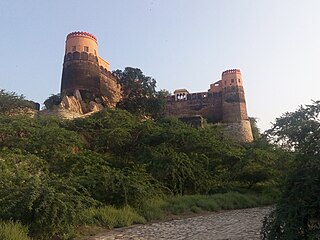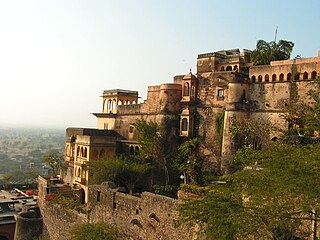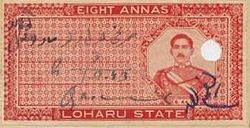
Balaji Baji Rao, often referred to as Nana Saheb I, was the 8th Peshwa of the Maratha Confederacy. He was appointed as Peshwa in 1740 upon the death of his father, the Peshwa Bajirao I.

Shekhawati is a semi-arid historical region located in the northeast part of Rajasthan, India. The region was ruled by Shekhawat Rajputs. Shekhawati is located in North Rajasthan, comprising the districts of Neem Ka Thana, Jhunjhunu, Sikar that lies to the west of the Aravalis and Churu. It is bounded on the northwest by the Bagar region, on the northeast by Haryana, on the east by Mewat, on the southeast by Dhundhar, on the south by Ajmer, and on the southwest by the Marwar region. Its area is 13,784 square kilometers.

Chhatri are semi-open, elevated, dome-shaped pavilions used as an element in Indo-Islamic architecture and Indian architecture. They are most commonly square, octagonal, and round. Originating as a canopy above tombs, they largely serve as decorative elements as opposed to functional elements. The earliest examples of chhatri being used in the Indian Subcontinent were found in the Shrine of Ibrahim in Bhadreswar, constructed between 1159 and 1175 AD.
Rajgarh, is a city, municipality, tehsil and Legislative Assembly seat in Churu district of northern part of Rajasthan state in India. It lies in Shekhawati region at an elevation of 239 metres (784 ft). To distinguish Rajgarh from several other places with same name, Sadulpur has become a synonym of Rajgarh town's name in recent times.
Bhiwani is a city and a municipal council in Bhiwani district in the state of Haryana. Besides being a seat of spiritual learning, the city is at the centre of regional politics and hometown of three former Haryana chief ministers: Bansi Lal, Banarsi Das Gupta and Hukum Singh. It is located 128 km west of national capital New Delhi.
Siwani is a town and a municipality located approx. 58 km from Bhiwani city in Bhiwani district in the north Indian state of Haryana. It is the administrative headquarters of Siwani tehsil.

The Daly College is a group of institutions consisting of a co-educational private boarding, day school, a private junior school, an undergraduate management school and a postgraduate business school, located in Indore, Madhya Pradesh, India. It was founded by Sir Henry Daly of the British Indian Army during India's colonial British Raj, following an English public school model. The school started in 1870 as the Residency School. It was then renamed as the East Rajkumar College in 1876, and in 1882, it came to be known as The Daly College. It was established by the Resident Governor of the erstwhile Presidency, to educate the children of the royalty, nobility and aristocracy of Central Indian Princely States of the 'Marathas', 'Rajputs', 'Mohameddans' and 'Bundelas'. It is one of the oldest co-educational boarding schools in the world.
Tain is a village in the Jhunjhunu district, India. It is part of the Shekhawati region of Rajasthan.

Fort Madhogarh is located in Madhogarh Village, 42 km from Jaipur off the Jaipur - Agra highway. Fort Madhogarh was built by Madho Singh Ji nearly 400 years ago and renovated and converted into a heritage hotel by Thakur Bhawani Singh Ji in July 2000.
Jojawar is a village located in Marwar Junction tehsil of Pali District in Rajasthan State, India. The mountains of the Aravalli Range are very near to this village. Jojawar is the location of the Jawahar Navodaya Vidyalaya school for Pali District, located about 1.5 km away on the Marwar Junction road.

Bharatpur State, which is also known as the Jat State of Bharatpur historically known as the Kingdom of Bharatpur, was a Hindu Kingdom in the northern part of the Indian subcontinent. It was ruled by the Sinsinwar clan of the Hindu Jats. At the time of reign of king Suraj Mal (1755–1763) revenue of the state was 17,500,000 rupees per annual. The major architecture of this state include Lohagarh Fort and Deeg Palace.

Bapora is a village in the Bhiwani district of the Indian state of Haryana. There is a Tomb of Sant Baba bhagwan Dass ji who was famous palmist. It lies approximately 7 kilometres (4.3 mi) west of the district headquarters town of Bhiwani. As of the 2011 Census of India, the village had 1,657 households with a total population of 34,332 of which 17,651 were male and 16,681 female. The major population of area is Brahmin and Rajput.

Madhogarh Fort is a fort located on top of Madhogarh Hill in the Aravalli mountain range, near Madhogarh village, in the Mahendragarh district of Haryana state in India. It is located 12 kilometres (7.5 mi) from Mahendragarh's Satnali Chowk on SH27 Mahendragarh-Satnali-Loharu State Highway. In the Madhogarh village, there are several old havelis of interest to tourists, built in the vernacular Hindu architecture in the style of Shekhawato havelis.
Madhogarh is a village in Mahendragarh district, Haryana, India. It is located at the foot of Madhogarh Hill of Aravalli Mountain Range. Madhogarh Fort is on top of the hill.

Khetri Mahal, also known as the Wind Palace, whose ruins are an example of palace architecture in the Indian state of Rajasthan.
Mangali, near Badya Jattan, is a village of more than 10,000 population with 5 gram panchayat in it, the only village in Haryana having 5 panchayat in single village, of Hisar-1 Rural Development Block, Nalwa Chaudhry and Hisar of Hisar District of Hisar Division in the Haryana state of India.
Mandholi Khurd, next to Mandholi Kalan, is a village and administrative unit with a democratically elected panchayat samiti in the Loharu, Siwani Tehsil of Bhiwani District under Bhiwani-Mahendragarh Lok Sabha constituency and Hisar Division of Haryana state.
Loharu Fort, built in 16th century, is a state protected archaeological monument in Loharu town in Haryana state of India. Fort is part of interstate Shekhawati region which lies on the either side of Haryana-Rajasthan border in the sandy bagar tract.
Apa Khande Rao was a general under Maharaja Mahadaji Scindia of the Scindia dynasty that ruled Gwalior State. He brought Mughal emperor Shah Alam II, and most of Haryana under the control of Maratha Empire in 1790s. He joined the maratha army after the Battle of Lalsot against the Rajput kingdoms of Jaipur and Jodhpur. He had commissioned the services George Thomas to conquer Haryana by subduing Rajputs of Rajasthan, Kachawa Shekhawat thakur rulers of Haryana and Shekhawati, Sikhs misl of Haryana, Mughals and Bhatti Muslim Rajputs.













